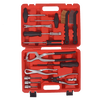Country information
Location
Spain, also known as the Kingdom of Spain, is a developed Mediterranean country in southern Europe. It shares borders with France and Portugal. The capital city is Madrid, located in the centre.
Population
Spain had a population of 44.4 million in 2023, as per Instituto Nacional de Estadísta data. In 2022, the World Bank reported that Spain had the 30th largest population in the world (behind Burundi, Tunisia, and Bolivia, but
ahead of Haiti, Jordan, and the Dominican Republic).
Wealth
Spanish households have a less-than-average disposable income of USD 27,155 per annum. This contrasts slightly with the average disposable income of USD 30,490 per annum, according to the Organisation for Economic Cooperation
and Development (OECD). However, the Spanish economy is set to improve. In 2023, the economy is expected to have grown by 2.4%, as published in the European Commission's report.
Language
The official language of Spain is Castillian Spanish. Each region in Spain has an additional official language, for example, Valenciano in Valencia, Catalan in Catalonia, and Basque in the Basque Country. Locals in each area
appreciate the availability of these languages on websites. A recommendation is to include English on your dropshipping website due to the number of international students and expats in Spain.
Dropshipping in Spain
How is the ecommerce market?
- The ecommerce market is expected to see a compound annual growth rate (CAGR) of 6.2% between 2023 and 2027 (eCommerceDB, 2023).
- It is estimated that the Spanish ecommerce market will be worth USD 47.52 billion by 2028 (Statista, 2024).
- Ecommerce penetration rate of 71% (Statista, 2023).
- 61% of Spaniards make cross-border purchases (DHL, 2023).
- The biggest factor influencing an online sale in Spain is price. 56% of Spaniards say that low cost is the most important factor when doing online shopping (TGM Research, 2022).
- 56% of Spanish online consumers buy from China if they make a cross-border purchase (DHL, 2023). The USA (21%) follows closely behind, along with the UK (18%).
Spain's ecommerce market is growing after the country's slow start to digitise. This Mediterranean nation has a history of economic distress that dates back to before WWI, including late industrialisation, extremely high levels
of unemployment, and a movement of nationals emigrating to neighbouring countries in search of work.
Since joining the European Union, amongst other trade, economic, and political alliances, Spain's economy has healed. Today, Spain's ecommerce market is one of the largest in Europe, ahead of wealthy nations such as the
Netherlands.
Covid-19 also helped to expand Spain's ecommerce market, with Spanish consumers gaining confidence in digital purchases. According to data from Mark Wide Research in 2024, changing customer preferences and improvements in
digital technology and parcel logistics have been factors in the acceleration of ecommerce.
How much do Spanish online shoppers spend?
Data from DHL's Online Shopper Report for Spain 2023 found interesting trends regarding how much Spanish shoppers are willing to spend online. These are the figures:
- €50 - 250 per month: 58% of Spanish consumers usually spend this total amount on online goods.
- €0 - 50 per month: 35% of Spanish consumers have a very low budget for online shopping.
- €250+ per month: 7% of Spanish consumers are willing to consistently spend a large amount on online goods.
The report found that 1 in 10 (12%) of consumers in Spain spent over €100 on their last online purchase. This figure may increase, however, there's still a large portion of the Iberian population that would rather hit the shops
in person. According to a 2022 Statista survey, 25% of Iberian shoppers prefer to see and touch a product before buying.
How often do Spaniards shop online?
Spanish shoppers are some of the most frequent online shoppers in Europe, says the 2022 TGM Research Report. There are more Spanish consumers (12%) who make an online purchase two or more times a week than in Belgium, Croatia,
France, Germany, Italy, the Netherlands, Portugal, Serbia, and Switzerland. Only the UK, Denmark, and Poland beat Spain in online shopping frequency.
The number of Spanish shoppers that make an online purchase once a week falls in line with the European average of 15%. Spain is the 7th European country for the highest number of shoppers that purchase online 2-3 times per
month or more.
Product categories with high sales
Spain's online annual spending is split into the following categories of consumer goods, as per Data Reportal, 2023:
| Rank |
Retail category |
Revenue in 2022 |
| 1 |
Fashion |
USD 8.72 billion |
| 2 |
Electronics |
USD 7.75 billion |
| 3 |
Personal and household care |
USD 4.12 billion |
| 4 |
Toys, hobby, and DIY |
USD 3.18 billion |
| 5 |
Food |
USD 2.70 billion |
| 6 |
Furniture |
USD 2.68 billion |
| 7 |
Physical media |
USD 1.76 billion |
| 8 |
Beverages |
USD 1.31 billion |
The biggest ecommerce players in Spain
According to Similarweb in January 2024, the most popular ecommerce players in Spain are listed in the following table:
| Rank |
Ecommerce retailer |
Category |
| 1 |
Amazon.es |
Online marketplace |
| 2 |
Elcorteingles.es |
Physical department shop with an online marketplace |
| 3 |
Aliexpress.com |
Online marketplace |
| 4 |
Wallapop.com |
Online classified ads |
| 5 |
Milanuncios.com |
Online classified ads |
Spanish shoppers enjoy using online marketplaces to compare prices, find good deals from cross-border sellers, and benefit from fast delivery. Not surprisingly, Amazon takes first place as the most popular online marketplace.
High internet penetration in Spain
Much of Spain's population has access to the internet and uses it regularly. In Data Reportal's 2023 report, Spain had an internet penetration rate of 94.9% (45.12 million) compared to the global average of 64.4%.
The same report estimated that Spaniards spend approximately 5 hours and 45 minutes browsing the internet across all devices. Internet time is split almost evenly between laptops and PCs (2 hours and 52 minutes) and smartphones
(2 hours and 53 minutes).
Data Reportal also found that almost half of Spaniards (51.1%) use the internet with the primary goal of researching products and brands.
Use of smartphones
Estimates from Statista found that there were 41.29 million smartphone users in 2023. That's 93% of the population that owns a smartphone and uses it at least once per month. Statista predicts there will be 44.89 million
smartphones in Spain by 2028.
A 2022 TGM Research Report found that 75% of Spanish shoppers prefer to use their smartphones to make online purchases. Due to the high use of smartphones for shopping, it is important to have a dropshipping website that is
responsive for smartphone users.
Delivery services in Spain
The main delivery services in Spain are Correos (the national postal service), DHL, FedEx, UPS, and SEUR, according to Byrd 2023.
A very high number of Spaniards (18%) used an ecommerce parcel locker to collect their online goods, says TGM Research. This is one of the highest in Europe, with only Denmark (24%) and Poland (64%) using parcel lockers more.
Saving money with ecommerce delivery costs
According to Data Reportal in 2023, the number one driver to encourage Spanish shoppers to complete an online order was free delivery, as reported by 67.4% of consumers. Choosing a dropshipping programme with free deliveries to
Spain is a great way to pass on savings to Spanish consumers. The dropshippingXL programme by vidaXL includes the benefit of free delivery to European countries.
What is dropshipping?
Dropshipping is an online retail business model. A manufacturer sends items directly to customers on behalf of a seller that advertises the manufacturer's goods. The seller doesn't store, pack, or ship the goods themselves. For
example, by signing up with dropshippingXL, you can advertise and sell vidaXL products online. When you make a sale, we send it to your customers directly from our Polish and Dutch warehouses.
To conclude
The ecommerce market in Spain is undergoing impressive growth. What used to be a country that greatly preferred the in-store shopping experience, now has more trust and confidence in online shopping.
The presence of multiple delivery options and couriers is helping in this shift. Due to some of the rural population and normal complications with home parcel deliveries (couriers unable to access communal buildings or consumers
not being at home to accept the delivery), the Spanish appreciate flexible delivery options. These include delivery to a local pick-up point and parcel lockers.
It's worth noting that Spaniards love low-prices and bargain deals. If you can offer competitive prices and free delivery from your dropshipping website, then it could experience better success according to the statistics above.
It's worth noting that Spaniards love low-prices and bargain deals. If you can offer competitive prices and free delivery from your dropshipping website, then it could experience better success according to the statistics above.








































